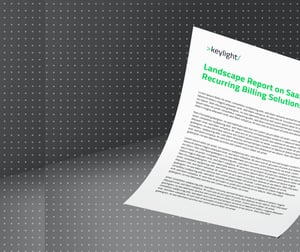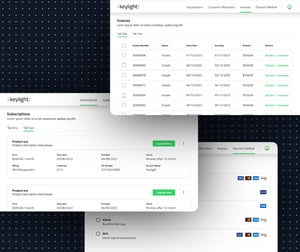Evolving subscription billing requirements
Managing complexity in scaling businesses
When you start a subscription business, billing is usually quite simple - there's a limited product range with a limited number of plans and price variations.
However, as the business grows, the nature of a recurring billing model and subscription management is that it gets more complex, accommodating different customers, markets and more nuanced use cases. The challenge is not merely a matter of processing volume, but also protecting your number one asset–your customer base.
Where you might be able to test pricing, packages and processes in the early days by trial and error, as your business grows the risk involved with product and pricing updates is greater. Yet, not to continue evolving and updating is the greatest risk of all in a competitive market.
For that reason, you need billing architecture that will allow you to experiment and build out sophisticated customer journeys that fulfil evolving customer expectations. It needs to enable you to gather data and roll out tested updates seamlessly and sensitively to avoid customer churn.
In this article we look at the complications presented to billing architecture as your subscription business scales, and what you need in your billing engine to overcome them.
The nature of the subscription business is to allow for evolution, and this is where choosing the right billing solution is a strategic decision to be prepared for the future.
Billing architecture complications
Traditional vs modern subscription billing
To understand the complications that arise in billing architecture as subscription businesses grow, we need to look at the traditional subscription mindset. Legacy billing systems are created in isolation from the rest of the customer journey. However, in finance-driven ecosystems, they are used as the foundation of every customization for user requirements and customer journeys. This not only cost a lot but also limits the scalability of the entire subscription business.
In subscription businesses, customer experience is inextricably linked to recurring billing, so you need a sophisticated engine where everything can work together. Complexities arise because of a disconnect between customer experience and finance—it is, in effect, about monetizing relationships.
The fundamental attributes of the billing architecture
- Consistency of experience
- The ability for the system to consistently update itself
For integrated systems to function consistently as a whole - The ability to collect consistent customer journey data, including billing
- For customers to consistently feel valued by your organization
As you develop your subscription business you will build an enormous web of product-price options and different journeys for customers, to the point where a traditional billing system will quickly be unable to handle it unless an immense amount of time and budget is invested. As new strategies come in, small changes will become cumbersome in legacy systems and inevitably lead to errors with the more manual changes that are required by your team.
The main areas of complication tend to result from the following:
Subscription management
Managing subscriptions, product catalogs, prices, and discounts
Adapting to change is a fundamental part of the long-term sustainability of a subscription business and its growth capacity.
Experimenting with new pricing and product offerings is an essential part of achieving that. It enables you to continually monetize customer relationships as well as make sure your customers get value for money.
Pricing can be a powerful tool for business growth, but when changes are not managed well they can result in customer churn and reputational damage instead. This is why testing and experimentation is essential–data, after all, is king - followed by a seamless rollout of new offers is a priority.
Traditional billing engines don't offer the flexibility to experiment with new prices and discounts, and they fail to frictionlessly launch new subscription offerings. Systems need to be robust enough to adapt to changes quickly at all times.
Billing software limitations
Using conventional approaches for modern businesses
For many subscription businesses a piecemeal approach to developing the different components of the organization leads them to implement a traditional billing system, which works acceptably at the start.
However, this quickly becomes clunky, error ridden and time consuming as a business with recurring revenue grows. Subscription businesses require a holistic approach to the development of the systems and processes, considering the customer experience and user experience from end-to-end and with one eye always on the future.
A lack of usability
The importance of user experience
The user experience - both in terms of the customer and your team - is one of the cornerstones of keylight's approach to subscription businesses. The reason is that by making a system easy for customers to use, you remove any barriers to entry for customers, as well as any reason not to retain the subscription. For members of the team, ease of use facilitates a smoother billing workflow and, as a result, a more seamless experience for your customers.
With traditional billing systems, users are not a consideration - the focus is entirely on financials. Although that is clearly important, without the different users there's no finance to manage, which means the architecture needs to consider the people using it in order to be inherently useful to the business.
Setting up products, creating quotes, entering orders and making sure that invoices are correct all take time and are all processes that are prone to error when done manually. On a small scale, it's possible to alter and check these different elements, but volume and cumulative growth are central to subscription business success. At scale, it's impossible to do all these things manually - it takes too long and the margin for error is too large, both of which will undermine your customer experience.
A lack of connectivity
Fostering a healthy and extensible tech ecosystem
Subscription businesses need to be thought of as living, breathing entities in their own right. More than merely an infrastructure that enables you to enact your business, the systems and processes you use are an ecosystem where the different components need to communicate with one another. They also need to have the capacity to learn, adapt and evolve in response to changing markets and customer needs.
When it comes to the billing system, it has to be connected with each of the processes within the customer journey and business functionality. Connectivity is what allows subscription businesses to be agile - to gather data at each point in the customer journey, to observe customer behaviors, to see where challenges occur, to limit churn and to continue monetizing customer relationships. Without connectivity you cannot have a complete picture of what's happening and as a result you cannot have the information you need to evolve and grow based on anything more tangible than guesswork.
Scaling subscription billing operations
Breaking free from recurring billing complexities
Billing only gets complex when your subscription architecture does allow for adaptation and is based on customizations and integrations for proper customer journeys and sale process.
With subscriptions, the billing engine has to be able to charge for every business use case with any combination of products you want to offer. The system has to be able to accommodate that and go through the alterations needed to seamlessly roll out offerings, which means you need a more open system that is able to evolve.
To do that, your system needs the following:
A flexible billing architecture
Adapt to growth with versatile subscription billing
This ability to grow and evolve is fundamental to subscription business sustainability. Flexibility and unity in the data model is central to making that happen.
In reality, what that means is that your billing system needs to be able to accommodate the many variables it's likely to encounter as you grow–as you add new products and alter pricing options, but also as you enter new geographical markets, and accommodate external factors like tax alterations and different payment methods.
When your recurring billing is seamless, it supports great customer experience and sustainable subscription business growth.
Things to consider for new customers
- Different payment methods such as credit cards, debit cards and wallets.
- You will need backup payment gateways, advanced invoicing options, prorations, credits and refunds, promotion support, and payment recovery or dunning.
- Different customer groups may mean you need to accommodate different billing periods.
Things to consider for new geographies
- Different tax laws
- Different currencies
- New billing rules
- Support for different languages
Things to consider for new prices
- Grandfathering existing subscriptions
- Versioned price books
- Flexible subscription plan management
Conscious planning and strategic thinking
Keep future subscription requirements in mind
It's important that the subscription billing system can fulfill your current business needs, but many forget that these requirements will change and evolve over time. One of the great advantages and challenges of a subscription business is accepting that you can't know everything on day one. Even so, many business leaders feel this presents a choice between building for complexity in advance and running the risk of over-engineering, or addressing complexity as it arises, which can be overly complicated and lead you to miss out on opportunities.
Subscription billing software needs to provide these fundamental elements for scaling businesses
- A low-code and API-first approach that allows your business to easily expand product revenue
- A rule-based platform that enables admins to pivot strategies and orchestrate the operational processes that follow at scale
- Structured data collection that enables the prediction of customer needs and response to them. This aspect is particularly crucial as a business grows.
Scale billing operations with ease
Prepare for your next revenue milestone
Subscription businesses are designed to grow; it is part of the definition of their success. However, growth by its very nature begets complexity. Knowing this from the outset means you can plan for the unknown, adopting the mindset, technologies, systems, processes and growth partners that allow for flexibility and business evolution.
By acknowledging this from the start, you can put systems in place that enable you to turn your time and resources towards product improvement instead of time-consuming workarounds, especially when it comes to your billing engine.
By adopting a unified subscription business system, like keylight, it can take the burden out of your hands and manage all complexities whilst easily scaling with your growth.

Power your business
with the right subscription solutions
![]() Book a free consultation
Book a free consultation
Power your business
with the right subscription solutions
![]() Book a free consultation
Book a free consultation

Explore keylight's superior value compared to conventional subscription platforms
![]() Compare now
Compare now
Explore keylight's superior value compared to conventional subscription platforms
![]() Compare now
Compare now




